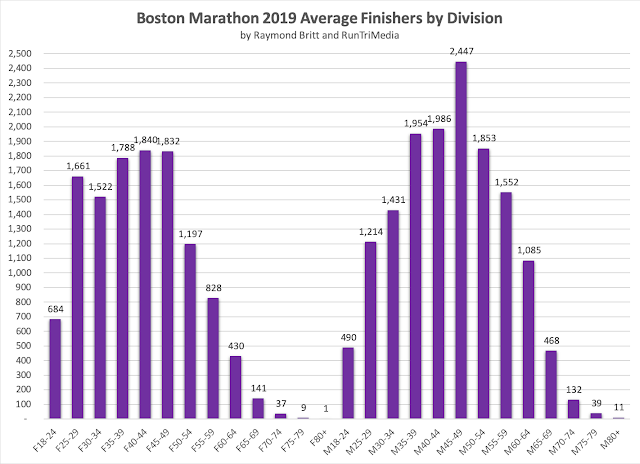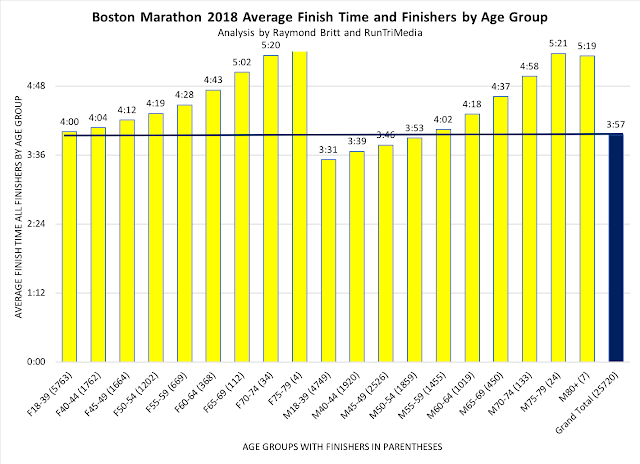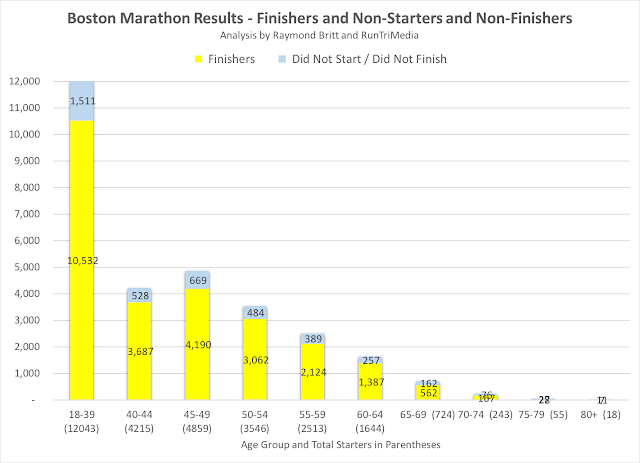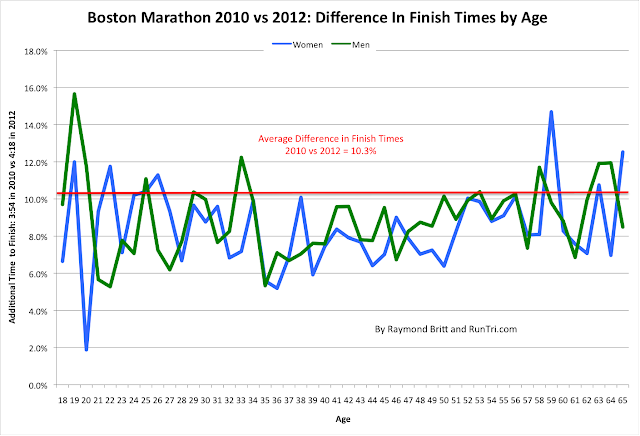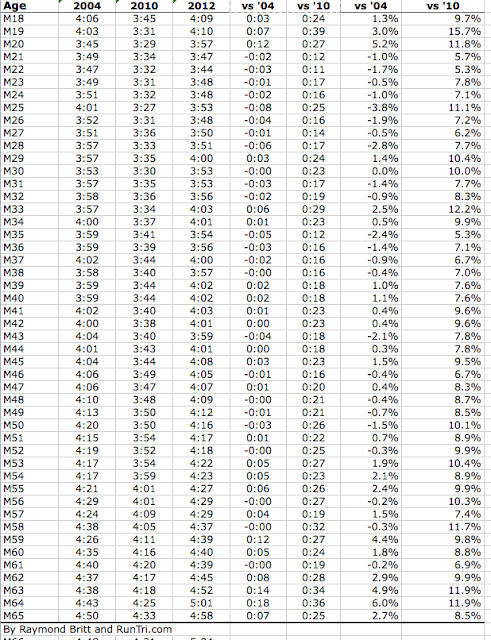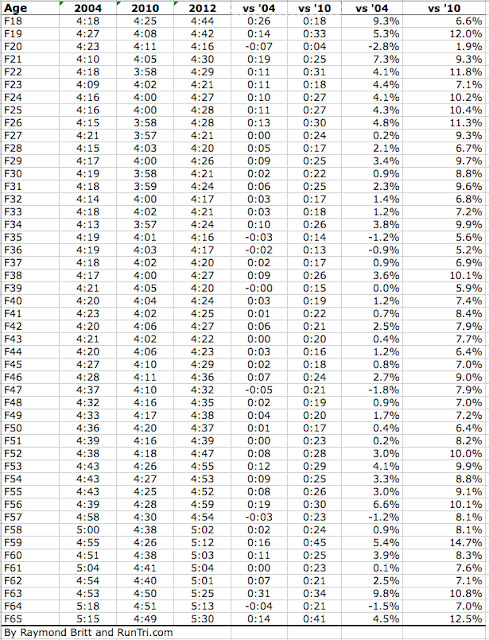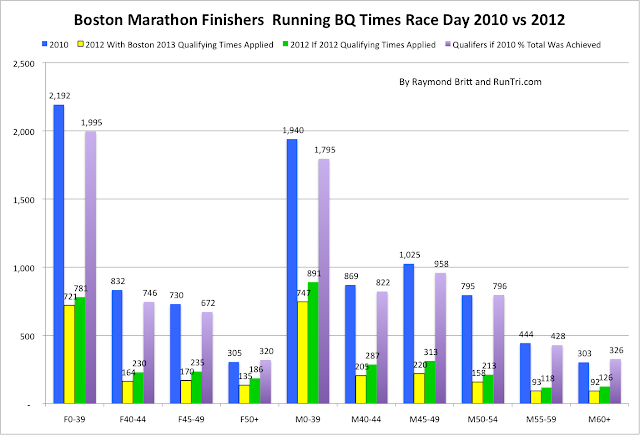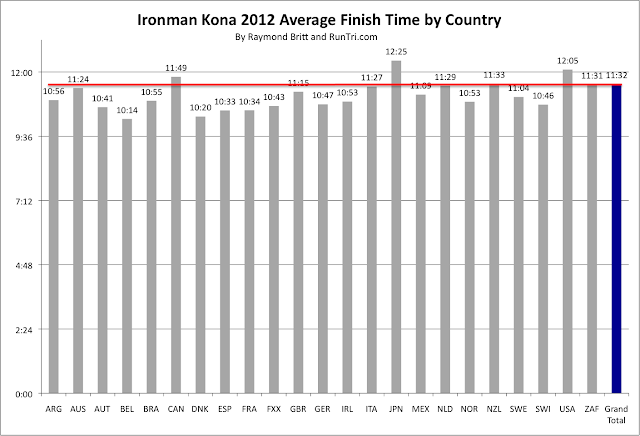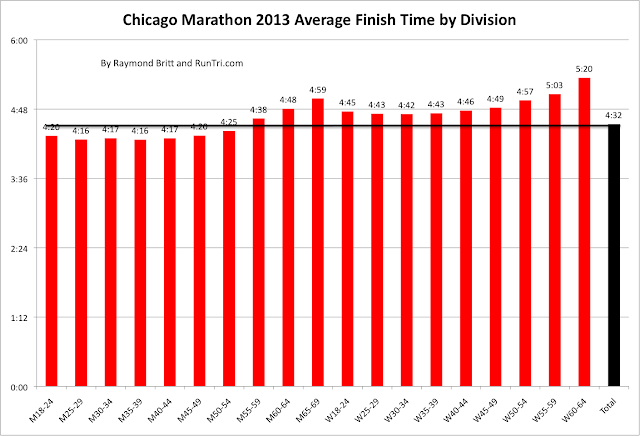By Raymond Britt and RunTriMedia
More than 26,600 runners finished the 2019 Boston Marathon in solid overall average time of 3 hours, 53 minutes. By comparison, the average finish time at Boston 2000 to 2019 is just a minute slower, 3:54. Notably, the 2019 average was 4 minutes faster than the average time of 3:57 in terrible weather conditions in 2018.
We've crunched the numbers to illustrate the dynamics of Boston Marathon 2019 in several dimensions on the following charts, covering:
At the next level of detail, here are the average finish times by gender and division.
To find individual 2019 race results, visit www.baa.org. Take a look at our elite race photos, too.
——————
2018 Recap
Rough year at the 2018 Boston Marathon as runners had to endure what some are calling the worst weather conditions in three decades: cold, rain, wind, and wind chill.
The elites seemed especially punished by the weather, but believe it or not, the average finish time for all in 2018, 3:57, was one minute faster than the 3:58 in 2017.
Here we present our annual comprehensive results analysis for all starters, finishers, age groups and the impact of weather on finish times, plus a link to BAA.org's searchable results.

Our analysis of Boston Marathon from the years 1999 to 2018 indicates the average finish time is 3:54; three hours and fifty-four minutes. That's at least 25 to 30 minutes than the average time of the top 25 marathons.
But there's so much more specificity we can provide about average finish times. We've crunched the numbers to illustrate:
Track your 2018 athlete throughout the race with real-time results hosted by the Boston Athletic Association, at this link:
Boston Marathon Average Finish Times 2017 by Age Group
Boston Marathon Average Finish Times 2017 by Age Group by Wave
More than 26,600 runners finished the 2019 Boston Marathon in solid overall average time of 3 hours, 53 minutes. By comparison, the average finish time at Boston 2000 to 2019 is just a minute slower, 3:54. Notably, the 2019 average was 4 minutes faster than the average time of 3:57 in terrible weather conditions in 2018.
We've crunched the numbers to illustrate the dynamics of Boston Marathon 2019 in several dimensions on the following charts, covering:
- Average Finish Times 2000-2019: Overall Average 3:54
- Boston 2019 Average Finish Time by Division
- Comparison of Boston Average Finish Times by Division 2017, 2018, 2019
- Boston Marathon Finishers each Year 2000-2019
- Boston Marathon Finishers by Division 2019
- Comparison of Boston 2019 Finishers by Gender and Division
- Comparison of Boston Finishers by Gender and Division 2017, 2018, 2019
- Weather vs Finish Times 1999-2019: Correlation between Temperature and Finish Time by Year
At the next level of detail, here are the average finish times by gender and division.
To find individual 2019 race results, visit www.baa.org. Take a look at our elite race photos, too.
——————
2018 Recap
Rough year at the 2018 Boston Marathon as runners had to endure what some are calling the worst weather conditions in three decades: cold, rain, wind, and wind chill.
The elites seemed especially punished by the weather, but believe it or not, the average finish time for all in 2018, 3:57, was one minute faster than the 3:58 in 2017.
Here we present our annual comprehensive results analysis for all starters, finishers, age groups and the impact of weather on finish times, plus a link to BAA.org's searchable results.

Our analysis of Boston Marathon from the years 1999 to 2018 indicates the average finish time is 3:54; three hours and fifty-four minutes. That's at least 25 to 30 minutes than the average time of the top 25 marathons.
But there's so much more specificity we can provide about average finish times. We've crunched the numbers to illustrate:
- Boston Marathon finish times 2000 to 2017,
- details on 2017 by age group and by age group within each of four waves
- Compare Boston 2012 against both Boston 2004 and Boston 2010 by race division, by gender and age, by city, by Boston Qualifiers, and more.
Track your 2018 athlete throughout the race with real-time results hosted by the Boston Athletic Association, at this link:
| 2017 Finish Times by Age Group, Wave, City |
Racing Boston: Strategy, Pacing, Weather
|
 |
| Desiree Linden Wins Boston Marathon 2018 |
Boston Marathon Average Finish Times 2017 by Age Group
Boston Marathon Average Finish Times 2017 by Age Group by Wave
Boston Marathon 2012
- Average Finish Time: 4:18:27
- 2012 vs 2010: 28 minutes slower, or 10%, compared to 2010's 3:50
- 2012 vs 2004: 5 minutes, or 2%, slower: 4:18 vs 4:13
- Boston 2013 Qualifiers: 13% of finishers qualified for 2013 vs 41% in 2010 (16% if Q Times same as 2012)
- Cities Represented: Finishers from 5,809 global cities finished Boston (see finish times by city and division).

Boston 2012 Runner Stats: Average Finish Time, Runners, Finishers, DNS, DNF, Deferred to 2013
- Average Finish Time: 4:18:27 (vs 3:51+ 12 Year Average)
- Finishers: 21,554 (95.9% of starters); 8,966 Women, 12,588 Men
- Entrants: 26,656 runners entered to run the 2012 Boston Marathon
- Qualified Runners: 20,081 -- see Qualifying for Boston for details
- Non-Qualified Runners: 6,575 runners received entry via charity or other entities
- Did Not Start -- No-Shows: An estimated 3,803 entrants did not pick up their bib numbers
- Did Not Start -- Weather Deferral Group: Runners World reports 427 eligible for deferral to 2013
- Runners: An estimated 22,480 started the race in Hopkinton
- Did Not Finish: 926, 4.1%
- For more, see our historical Entrants, DNS and DNF rates, Finishers
Results Analysis: Average Finish Times 2000 to 2011 -- 2012 Avg. Time = 4:18:27
Finish Times by Age Group 2011: Average Time Overall = 3:54
Finish Times by Age 2010





